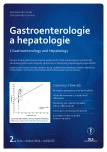Endoscopic submucosal dissection in the treatment of recurrent high-grade neoplasia of the rectum
Authors:
O. Urban 1,2; P. Fojtík 1; M. Kliment 1; Přemysl Falt 1
; M. Hanousek 1; O. Mikolájek 1; V. Zoundjiekpon 1; P. Holéczy 1,2; J. Örhalmi 1; M. Čegan 3
Authors‘ workplace:
Centrum péče o zažívací trakt, Vítkovická nemocnice, a. s., Ostrava
1; LF Ostravské univerzity, Ostrava
2; CGB laboratoř, Ostrava
3
Published in:
Gastroent Hepatol 2011; 65(2): 80-83
Category:
Digestive Endoscopy: Case Report
Overview
Endoscopic submucosal dissection is a suitable approach to the treatment of early neoplastic lesions that involves the upper gastrointestinal tract. The option to undertake such a procedure in cases of colo-rectal lesion is under continuous review. The aim of the this paper is to present a successful endoscopic submucosal dissection in the treatment of recurrent rectal neoplasia with non-lifting sign.
Key words:
endoscopic submucosal dissection – endoscopic mucosal resection – laterally spreading tumor
Sources
1. Ohkuwa M, Hosokawa K, Boku N et al. New endoscopic treatment for intramucosal gastric tumors using an insulated-tip diathermic knife. Endoscopy 2001; 33(3): 221–226.
2. Urban O, Vítek P, Fojtík P et al. Endoscopic submucosal dissection: Initial experience in the Czech Republice. Folia Gastroenterol Hepatol 2006; 4(1): 4–10.
3. Tanaka S, Oka S, Chayama K. Colorectal endoscopic submucosal dissection: present status and future perspective, including its differenciation from endoscopic mucosal resection. J Gastroenterol 2008; 43(9): 641–651.
4. Hotta K, Fujii T, Saito Y et al. Local recurrence after endoscopic resection of colorectal tumors. Int J of Colorectal Disease 2009; 24(2): 225–230.
5. Niimi K, Fujishiro M, Kodashima S et al. Long term outcomes of endosocpic submucosal dissection for colorectal epithelial neoplasms. Endoscopy 2010; 42(4): 723–729.
6. Saito Y, Fukuzawa M, Matsuda T et al. Clicnical outcome of endoscopic sumbucosal dissection versus endoscopic mucosal resection of large colorectal tumors as determined by curative resection. Surg Endoscopy 2009; 24(2): 243–352.
7. Sakamoto T, Saito Y, Matsuda T et al. Treatment strategy for recurrent or residual tumors after endoscopic resection. Surg Endoscopy 2010; 25(1): 255–260.
8. Toyonaga T, Inokuchi H, Man IM. Endoscopic submucosal dissection using water jet short needle knives (Flush knife) for the treatment of gastrointestinal epithelial neoplasms. Acta Endoscopica 2007; 37: 645–656.
9. Toyonaga T, Man IM, Fujita T et al. Retrospective study of technical ascpects and complications of endoscopic submucosal dissection for laterally spreading tumors of the colorectum. Endoscopy 2010; 42(9): 714–722.
10. Urban O, Fojtík P, Kliment M et al. Endoskopická léčba časného karcinomu žaludku: Vlastní výsledky v období let 2000–2009. Endoskopie 2009; 18(4): 156–161.
Labels
Paediatric gastroenterology Gastroenterology and hepatology SurgeryArticle was published in
Gastroenterology and Hepatology

2011 Issue 2
- Metamizole vs. Tramadol in Postoperative Analgesia
- Metamizole at a Glance and in Practice – Effective Non-Opioid Analgesic for All Ages
- Possibilities of Using Metamizole in the Treatment of Acute Primary Headaches
- Metamizole in perioperative treatment in children under 14 years – results of a questionnaire survey from practice
- Obstacle Called Vasospasm: Which Solution Is Most Effective in Microsurgery and How to Pharmacologically Assist It?
Most read in this issue
- Obtaining biopsies during endoscopic investigation of the gastrointestinal tract for selected inflammatory disorders
- Recommended procedure for small bowel examination in patients with Crohn’s disease
- Aetiology and pathogenesis of ulcerative colitis. Still more questions than clear answers
- Quantitative testing in colorectal cancer screening – a view of the near future
